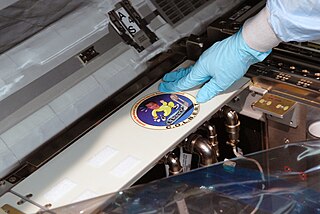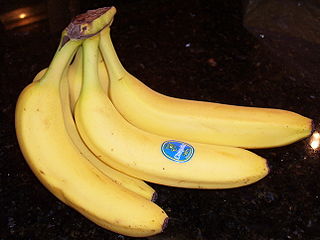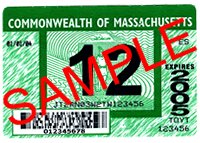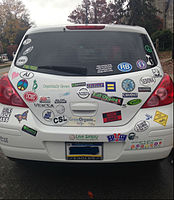
A vehicle registration plate, also known as a number plate or license plate or licence plate, is a metal or plastic plate attached to a motor vehicle or trailer for official identification purposes. All countries require registration plates for commercial road vehicles such as cars, trucks, and motorcycles, for hire. Whether they are required for other vehicles, such as bicycles, boats, or tractors, may vary by jurisdiction. The registration identifier is a numeric or alphanumeric ID that uniquely identifies the vehicle or vehicle owner within the issuing region's vehicle register. In some countries, the identifier is unique within the entire country, while in others it is unique within a state or province. Whether the identifier is associated with a vehicle or a person also varies by issuing agency. There are also electronic license plates.

A decal or transfer is a plastic, cloth, paper, or ceramic substrate that has printed on it a pattern or image that can be moved to another surface upon contact, usually with the aid of heat or water.

A sticker is a type of label: a piece of printed paper, plastic, vinyl, or other material with temporary or permanent pressure sensitive adhesive on one side. It can be used for decoration or for functional purposes, depending on the situation.

The Volkswagen Citi Golf is a right-hand drive 5-door hatchback manufactured and marketed by Volkswagen in South Africa from 1984 to 2009 as a facelifted version of the first generation Volkswagen Golf Mk1, which ceased production in Germany in 1983.

In bus advertising, buses and their related infrastructure is a medium commonly used by advertisers to reach the public with their message. Usually, this takes the form of promoting commercial brands, but can also be used for public campaign messages. Buses may also be used as part of a political or promotional campaign, or as a tool in a commercial enterprise.

An adhesive label or sticky label is a small piece of paper designed to be affixed to any surface, typically by the action of removing a layer of adhesive on the front or back of the label. The term adhesive refers to a sticky substance, while something that is self-adhesive implies that it will stick without wetting or the application of glue to the product.

The Scotsman is an automobile series that was produced by the Studebaker Packard Corporation of South Bend, Indiana, during model years 1957 and 1958, and a low-priced series of pickup trucks in 1958 and 1959. The name was based on the reputation of Scottish frugality, the cars being built for function and minimalism.

Meramec Caverns is the collective name for a 4.6-mile (7.4 km) cavern system in the Ozarks, near Stanton, Missouri. The caverns were formed from the erosion of large limestone deposits over millions of years. Pre-Columbian Native American artifacts have been found in the caverns. Currently the cavern system is a tourist attraction, with more than fifty billboards along Interstate 44 and is considered one of the primary attractions along former U.S. Highway 66. Meramec Caverns is the most-visited cave in Missouri with some 150,000 visitors annually.

A label is a piece of paper, plastic film, cloth, metal, or other material affixed to a container or product, on which is written or printed information or symbols about the product or item. Information printed directly on a container or article can also be considered labelling.

The Mitsubishi FTO is a front mid-engined, front-wheel drive coupe produced by Mitsubishi Motors between 1994 and 2000. Originally planned exclusively for the Japanese domestic market, its popularity as a grey market import to the United Kingdom, Ireland, Hong Kong, Singapore, Malaysia, Australia and New Zealand led to eventual limited distribution through Mitsubishi's official dealers in those regions at the tail-end of production. Upon its debut it won the Car of the Year Japan award for 1994–95, commemorated by a Limited Edition of the FTO GPX model.

In the United States, vehicle registration plates, known as license plates, are issued by a department of motor vehicles, an agency of the state or territorial government, or in the case of the District of Columbia, the district government. Some Native American tribes also issue plates. The U.S. federal government issues plates only for its own vehicle fleet and for vehicles owned by foreign diplomats. Until the 1980s, diplomatic plates were issued by the state in which the consulate or embassy was located.

A vehicle registration plate, also known as a number plate, license plate or licence plate, is a metal or plastic plate or plates attached to a motor vehicle or trailer for official identification purposes. The registration identifier is a numeric or alphanumeric code that uniquely identifies the vehicle within the issuing authority's database. In Europe most countries have adopted a format for registration plates that satisfies the requirements in the Vienna Convention on Road Traffic, which states that cross-border vehicles must display a distinguishing code for the country of registration on the rear of the vehicle. This sign may be an oval sticker placed separately from the registration plate, or may be incorporated into the plate. When the distinguishing sign is incorporated into the registration plate, it must also appear on the front plate of the vehicle, and may be supplemented with the flag or emblem of the national state, or the emblem of the regional economic integration organisation to which the country belongs. An example of such format is the common EU format, with the EU flag above the country code issued in EU member states.

Vehicle inspection is a procedure mandated by national or subnational governments in many countries, in which a vehicle is inspected to ensure that it conforms to regulations governing safety, emissions, or both. Inspection can be required at various times, e.g., periodically or on the transfer of title to a vehicle. If required periodically, it is often termed periodic motor vehicle inspection; typical intervals are every two years and every year. When a vehicle passes inspection, often a sticker is placed on the vehicle's windshield or registration plate to simplify later controls, but in some countries—such as the Netherlands since 1994—this is no longer necessary. Most US inspection decals/stickers display the month's number and the year.
Vehicle registration plates of Canada, also known as licence plates, are issued by provincial or territorial government agencies. Registration plates in Canada are typically attached to motor vehicles or trailers for official identification purposes. Some Canadian registration plates have unique designs, shapes, and slogans related to the issuing jurisdiction. For example, registration plates issued in the Northwest Territories are shaped like a polar bear. In Alberta, registration plates typically display the words "Wild Rose Country."
The U.S. state of Pennsylvania first required its residents to register their motor vehicles in 1903. Registrants provided their own license plates for display until 1906, when the state began to issue plates.

Common in auto racing, contingency sponsorship is a form of sponsorship whereby race teams place company decals on their vehicles in exchange for awards for winning or meeting certain performance goals. These awards can be monetary, or can include credits for free or discounted equipment.
Trax Models is a range of diecast model cars and buses in the scales of 1:24, 1:43 and 1:76 produced by Trax Corporation Pty Ltd. The line consists of vehicles made in China for the Australian market. The company is controlled by the Australian firm Top Gear, but the Top Gear name does not appear on Trax vehicles nor boxes. The company was formed in 1980, by John Eassie, initially involved with Australian model trains. John branched off into 1:43 diecast cars in 1986, with car models being distributed via the model train retailers. John sold the company to Frank Tregellas, previously General Manager of Matchbox Toys Australia and Matchbox Collectibles and Robert Hill who managed Matchbox Collectibles.

A wall decal, also known as a wall sticker, wall tattoo, or wall vinyl, is a vinyl sticker that is affixed to a wall or other smooth surface for decoration and informational purposes. Wall decals are cut with vinyl cutting machines. Most decals use only one color, but some may have various images printed upon them.
Tire lettering is the practice of moulding visible letters into, or drawing them on, the sidewall of an automobile's tires. In modern usage, the lettering is often big car brands or tire brands names, with custom lettering being a much smaller niche of that. It can also refer to other after market customizations to the side wall of the tire, such as the "white wall tire" look, but any color of the spectrum is available now, including "rainbow wall tires".























